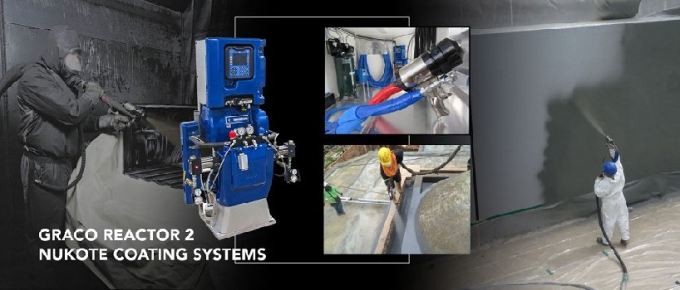Nukote XT plus is a fast set, rapid curing modified polyurea designed for use in application on concrete, steel or other substrates for protection against high acidic, alkaline chemicals in combination with moderate heat or pressure. Nukote XT plus is designed for acid and base environments and is a 100% solids flexible, aromatic, two component spray applied polyurethane polyurea. Nukote XT plus is suitable where anaerobic and aerobic waste by-products combined with elevated temperatures are expected. The product is commonly specified in conjunction with other Nukote products in monolithic compositions or as a geotextile composite for applications in immersion as liner or in secondary containment of chemical storage tanks. This aromatic polyurea elastomer exhibits good long term chemical resistance, thermal stability and UV resistance.
FEATURES:
-
100% solids with zero VOC
-
Fast reactivity and cure time resulting in almost immediate return-to-service time
-
Performs in constant process temperatures from -40 °F to 250 °F (-40 °C to 120 °C)
-
Maintains high physical properties on weathering
-
Seamless, resilient, flexible and tough
-
Superior chemical resistance –acids and bases (consult NCSI)
-
Good corrosion protection in chemical immersion
-
Low permeability waterproofing and protective membrane
TYPICAL USES:
-
Water, waste water and storm water plants and infrastructures
-
Mining containment, process equipment and distribution
-
Oil & gas and petrochemical containment and distribution
-
Treated water and desalination process, containment and distribution
-
Power generation; thermal, hydro, gas and nuclear process and containment
-
Primary & secondary containment of most liquid systems
-
Landfill containment.
COLORS:
Standard medium grey only. Custom colors, blended to match any RAL number, are available upon request subject to minimum quantity.
PACKAGING:
100-gallon (380-liter) drum sets, shipped in metal drums of 50 gallons (190 liters) each of side A and side B
10-gallon (38-liter) kits, shipped in plastic pails of 5 gallons (19 liters) each of side A and side B
275-gallon (1045 liter) totes.
COVERAGE:
Nukote XT plus may be applied at any rate to achieve the desired thickness. Calculation for theoretical coverage: 40 Ft2 /gal @ 40 mils (1 m²/liter @ 1mm).
STORAGE:
Nine to twelve months in factory delivered, unopened drums kept at 77° F (25° C). Keep away from extreme heat, freezing, and moisture. The use of drum heaters is encouraged to reduce material viscosity at low temperatures. Isocyanate or A side is sensitive to thermal cycling and low temperature if exposed and may require heating and filtering in extreme case of crystallization. Contact Nukote Technical service for the procedure
|
TECHNICAL DATA (All values @ 77 ºF / 25 ºC) |
US |
Metric |
|
Solids by volume (ASTM D2697) |
100% |
100% |
|
Volatile organic compounds (ASTM D2369) |
0 lb./gal |
0 gm/ lit |
|
Theoretical coverage |
40 ft2/gal @ 40 mils |
1m2/ lit @ 1mm |
|
Specific Gravity of materials (ASTM D792) |
A: 9.35, B: 8.43 lbs./gal |
A: 1.12, B: 1.01 kg/ liter |
|
Viscosity at 158 ºF/70 ºC in cps ±10% (ASTM D4878) |
A-260, B-450 |
A-260, B-450 |
|
Shelf life @ 77 ºF /25 ºC |
09 to 12 Months |
09 to 12 Months |
|
Tensile strength (ASTM D412-C) |
2250 to 2600 psi |
14 to 21 MPa |
|
Elongation (ASTM D412-C) |
50-100 % |
50-100 % |
|
Hardness (ASTM D2240) |
45 to 50 Shore D |
45 to 50 Shore D |
|
Flexibility (2mm mandrel ASTM D522) |
Pass |
Pass |
|
Water vapour transmission rate (ASTM E96) |
0.035-0.038grains/hr-ft2 |
0.2 to 0.3gms/hr-m2 |
|
Water absorption -24 hours (ASTM D570) |
~ 1 % |
~1% |
|
Crack Bridging @ -13 ºF/-25 ºC (ASTM C1305), 25 cycles |
Pass |
Pass |
|
Tear strength (ASTM D642 ) |
250 to 350 pli |
40 to 45 Kn/m |
|
Impact Resistance (ASTM G14), No Holidays |
> 175 in-lbf |
> 16 J (N-m) |
|
Fire Rating (ASTM E108) |
Meets Class A for Flame spread |
|
Flash point Pensky Martin |
>200 °F |
>93 °C |
|
Service temperature (Dry) |
-40 °F to 250 °F |
-40 °C to 120 °C |
|
Abrasion Resistance (ASTM D4060) weight loss |
< 20 mg loss Taber CS 17 wheel 1Kg/1000 rev |
|
PROCESSING PROPERTIES (Under standard lab conditions) |
|
Mix Ratio V/V |
1:1 |
|
Gel time |
6 to 20 seconds |
|
Tack free time (DFT & Temperature dependent) |
30 to 45 Seconds |
|
Post cure time |
24 hours |
|
Properties and values are highly dependent on equipment, spray gun, mix chamber temperature, pressure and related parameters. Variations are possible and expected. Values included above are per NCSI standard lab practices & methodology of draw down film at various dry film thicknesses. |
MIXING:
Nukote XT plus might not be diluted under any circumstance. Thoroughly mix Nukote XT plus Part B resin material with air driven power equipment until a homogeneous mixture and color is obtained. Always use dedicated spray equipment.
SURFACE PREPARATION:
Concrete:
The surface of a concrete subfloor should be dry, smooth, structurally sound and free of depression, scale, or foreign deposits of any kind. Remove all curing compounds. Abrasive blast, sweep blast or water blast to remove all latent material and expose voids. Use a good quality epoxy filler or mortar for void and spall filling, skim coat or repairs. Prime, fill imperfections in the substrate surface to limit out-gassing. All concrete substrates, on or below grade level should be tested for moisture content. On-grade or below-grade concrete floors or slabs should have a moisture barrier installed to protect from ground moisture. The surface preparation of concrete should meet and conform to Joint NACE 6/SSPC-SP 13 standards and achieve a concrete surface profile of CSP 3 to CSP 6as per ICRI Guideline No.03732 for optimum performance.
Metal:
All surfaces should be clean and free from contamination. The surface should be assessed and treated in accordance with ISO 8504, Abrasive blast the surface to minimum NACE-2/SSPC SP-10/Sa 2.5, as per ISO 8501-1, for a visual assessment of surface cleanliness with an anchor profile of 3 to 4 mils (75 -100 microns). Soluble salts must be removed to an acceptable levels. Refer to NCSI surface preparation manual for detailed procedures for different types of substrates.
APPLICATION:
Must be applied utilizing high-pressure, heated plural component spray proportioning equipment, such as Graco Reactor 2, or equivalent, capable of delivering materials without loss of pressure or drop in temperature for the appropriate hose length on a consistent basis. For optimum performance, the substrate should be abrasive blasted. Concrete substrates should be allowed to cure a minimum of 30 days. On concrete, Nukote XT plus should always be applied over a suitable primer for maximum adhesion. For all submersed or immersion applications, use of a suitable primer is absolutely essential. On horizontal surface applications, a texture “stipple” coat can be applied for non-skid purposes, after reaching the initial desired film thickness. Recommended DFTs are a function of the project specific requirements. Please review your specific project with Nukote technicians.
EQUIPMENT CLEAN UP:
Cured product may be disposed of without restriction. Uncured Isocyanate and resin portions should be mixed together and disposed of in accordance with local regulations. Containers should be disposed of according to local environmental laws and ordinances.
LIMITATIONS:
Do not open until ready to use, and store in a sealed container after opening. Adding a nitrogen blanket is strongly recommended for the ‘A’ component when storing after opening.
WARNING:
This product contains Isocyanate and curatives
CHEMICAL RESISTANCE:
Each Nukote product formulation has varying levels of resistance to specific chemicals. Please review the chemical immersion test data included in the Nukote Test Book for general resistance to specific chemicals at specific concentration levels. Chemical concentrations are complex and when combined with temperatures above ambient levels this complexity increases exponentially. Contact Nukote Technical Personnel for specific recommendations for chemical resistance prior to specifying these products in this application type. Consult with NCSI for more details on product and chemical resistance. The following chart is the results of Polyurea immersed in chemicals and tested as per modified ASTM D 3912.
|
Chemicals |
Resistance |
|
Hydrochloric acid 15% |
R |
|
Sulphuric Acid 50% |
R |
|
Phosporic Acid 15% |
R |
|
Acetic Acid 10% |
R |
|
Nitric Acid 25%, HF 10% |
R |
|
Water @ 176 ºF (80 ºC) |
R |
|
Diesel |
R |
|
Hydraulic Oil |
R |
|
Perchloric acid 60% |
R |
|
Sodium Hydroxide 50% |
R |
|
Ammonium Hydroxide 20% |
R |
|
Pottasium hydroxide 20% |
R |
|
Sodium Bicarbonate 30% |
R |
|
Sodium Hypochlorite 14% |
R |
|
Calcium Hydroxide 30% |
R |
|
Hydrogen sulphide (gas) |
R |
|
Sewage |
R |
|
Hydrogen proxide |
R |
R = Resistant, RC = Slight surface change or discolouration with no loss of hardness
Contact NCSI for more on chemical resistance details and list of chemicals tested


